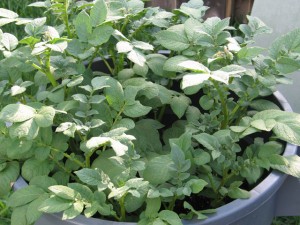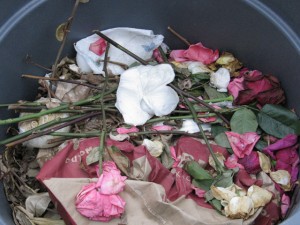Posted by Aimee | Posted in Compost, Experiments, Insects | Posted on 30-04-2009
Tags: Compost, fertilizer, Insects, soil, Watering
The weather here lately in the Houston area has been downright sopping wet. As I am sure many of you heard or saw large areas of Houston were flooded Tuesday, so much so I did not even get into work until 9:30A.M. I was fortunate enough to not have to sit in traffic, rather we waited to go to work until after the roadways had been cleared.
With all this water I was a little worried about my plants. My fancy, high tech shade providing devices (card board boxes) got so soggy they fell over on-top of the plants they were intended to protect and started squashing them. I braved the weather for just long enough to pull the boxes out of my raised garden beds and dart back indoors.
I am extremely glad to report that after a good once over this evening I am sure my plants are all doing well. Especially the potatoes! The only thing not intentionally planted is doing the best, though I attribute a lot of this to the fact that they were planted straight into compost and I have applied Micro-Life fertilizer to them and since all the rain and warm weather will not wash the nitrogen out and burn the plants like it can with non-organic fertilizers they are doing fantastic. They are a beautiful deep green and other than having to pick a couple of unidentified caterpillars off of them they are doing amazing, growing faster than any weed I have ever seen even.
About those caterpillars though, I should have taken a picture because the only picture I found that matched how they looked exactly labels it as an army caterpillar but by looking up pictures of army caterpillars I am rather unconvinced that is a correct identification. The caterpillar was velvety smooth looking and was black with two vivid, thin yellow stripes on its upper sides, almost so high they would be on its back. I may go out with a flashlight and see if I can find any more of these. Then I will get a picture put up and maybe one of you other Houston area gardeners can identify him for me.
I most certainly cannot have them eating those beautiful potato plants or my tomato plants either. I had read that potatoes were rather hard to grow in this area just like asparagus and peaches. I was worried enough about how well they would grow I almost just turned them under, now I am exceedingly glad I let them stay. Who knows if I will get any potatoes or not but the plants themselves look absolutely gorgeous! Here’s hoping there won’t be any more flooding!


